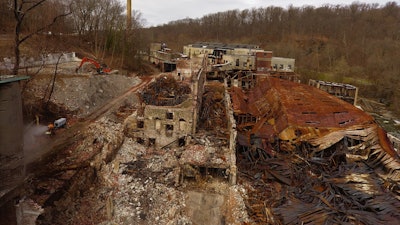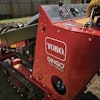
Information from this article was first published in Demolition Magazine and is being reused with permission from the National Demolition Association.
By Alexa Schlosser
 The location of the structures on Brandywine Creek made maneuvering through the jobsite particularly difficult.
The location of the structures on Brandywine Creek made maneuvering through the jobsite particularly difficult.
Bancroft Mills closed in 1961, and the building was acquired by Wilmington Piece Dye Company, which eventually folded in 2003. After that, a new property owner took over with plans of redeveloping the site into luxury townhomes and condos called The Overlook at Rockford Falls.
National Demolition Association (NDA) member Neuber Demolition & Environmental Services heard of the redevelopment plans and reached out with a bid. The company had performed some chemical cleanup there about a decade ago and is well-known in the area as a full-service demolition and environmental company.
“We were about ready to sign a contract and were on our way down to look at another job when the phone rang and the property owner said ‘Hey, Rockford Falls is on fire,’” says D’Orazio D’Orazio, operations manager at Neuber.
A slow start
After the buildings caught fire, “there was a little bit of downtime because the fire department had to do their investigation,” D’Orazio says. Neuber had already been a competitive bid, but it became more competitive after the fire due to its experience dealing with asbestos cleanup.
 Just prior to signing the demolition contract, the Rockford Falls buildings caught fire, creating an additional set of challenges for the demolition contractor.National Demolition Association
Just prior to signing the demolition contract, the Rockford Falls buildings caught fire, creating an additional set of challenges for the demolition contractor.National Demolition Association
“What you’re used to with a structure is changed during a fire,” D’Orazio says. “That caused insight on how we could demo. We had to be careful and set up differently because you would pull one area and the next thing you know, a wall would fall a hundred feet down the river because the mortar was at such a high temperature and being twisted and burnt.”
The team also had to work closely with the Delaware State Environmental Agency to ensure the demolition plan was safe for both the surrounding area and Neuber employees.
“We had to do some deposit samples to see where the debris would go, provide the PPE for employees so they weren’t being compromised and use misters for the dust because we didn’t want to contaminate any of the surrounding areas,” D’Orazio says.
Going in
The strategy for taking down the fire-damaged structures was to get inside the buildings, take the walls down, blast them on the structure, then take the structure down once it had collapsed on itself. After that, the crew would segregate and ship off most of the product.
 Neuber had to alter its demolition strategy to accommodate for the compromised structural integrity of the fire-damaged buildings.National Demolition Association
Neuber had to alter its demolition strategy to accommodate for the compromised structural integrity of the fire-damaged buildings.National Demolition Association
The buildings that weren’t damaged by the fire still brought their own set of challenges.
“One in particular was a five-story building that was cantilevered 15 feet out over top of the Brandywine, so that was a tricky one trying not to have a five-story building fall into a stream right next to the building,” D’Orazio says.
“We went in and gutted the building, did all the remediation out of there, then we gutted all the interior demo so all we had was slab and structure. We were able to piece that down inside the jobsite without that going into the Brandywine using our 65-foot high reach.”
The contractor used a combination of equipment for the project including:
- Three Hitachi 350 excavators
- One Hitachi 450 excavator with 60-foot boom and a processor
- One Kawasaki wheel loader, water truck, multiple skid steers and dust machines
- One JOhn Deere 750 bulldozer, multiple all-terrain platform lifts and all-terrain forklift
Other challenges
In addition to dealing with fire-damaged buildings, Neuber encountered a couple other unique challenges on this job. The location of the structures on Brandywine Creek made maneuvering through the jobsite particularly difficult.
“We only had access from one direction because you basically had a river on one side, townhomes on the back side and rock on the other side,” D’Orazio says. “It wasn’t like a normal demolition project where you have room. It was basically like working in an alleyway.”
Another challenge was a 220-foot stack just 90 feet away from existing townhouses.
 During the industrial revolution, early manufacturers harnessed hydropower from Brandywine Creek to drive the production of goods.National Demolition Association
During the industrial revolution, early manufacturers harnessed hydropower from Brandywine Creek to drive the production of goods.National Demolition Association
It was Neuber’s first implosion, and they worked with fellow NDA member Controlled Demolition Inc. to bring down the stack safely. “Working with Mark and his crew was an experience,” D’Orazio says. “They were a key part of that stack coming down.”
Toward the end of the project, Neuber had to make it through one more roadblock: crushing the blue granite stone comprising most of the buildings.
“Crushers don’t like blue granite,” D’Orazio says. “It was rough on the crushers. It was so sharp it would actually rip our belts once it went through the crusher. We had to re-crush a lot of the stone. That was toward the end of the project and almost set us back on the project timeline.”
Luckily, Neuber was able to finish the job on time with zero injuries.
Project statistics
- Average crew size: 8
- Project length: 8 months
- 3,000 tons of scrap recycled
- 4,000 tons of concrete and rock recycled
- Total recycle rate: 70%
















